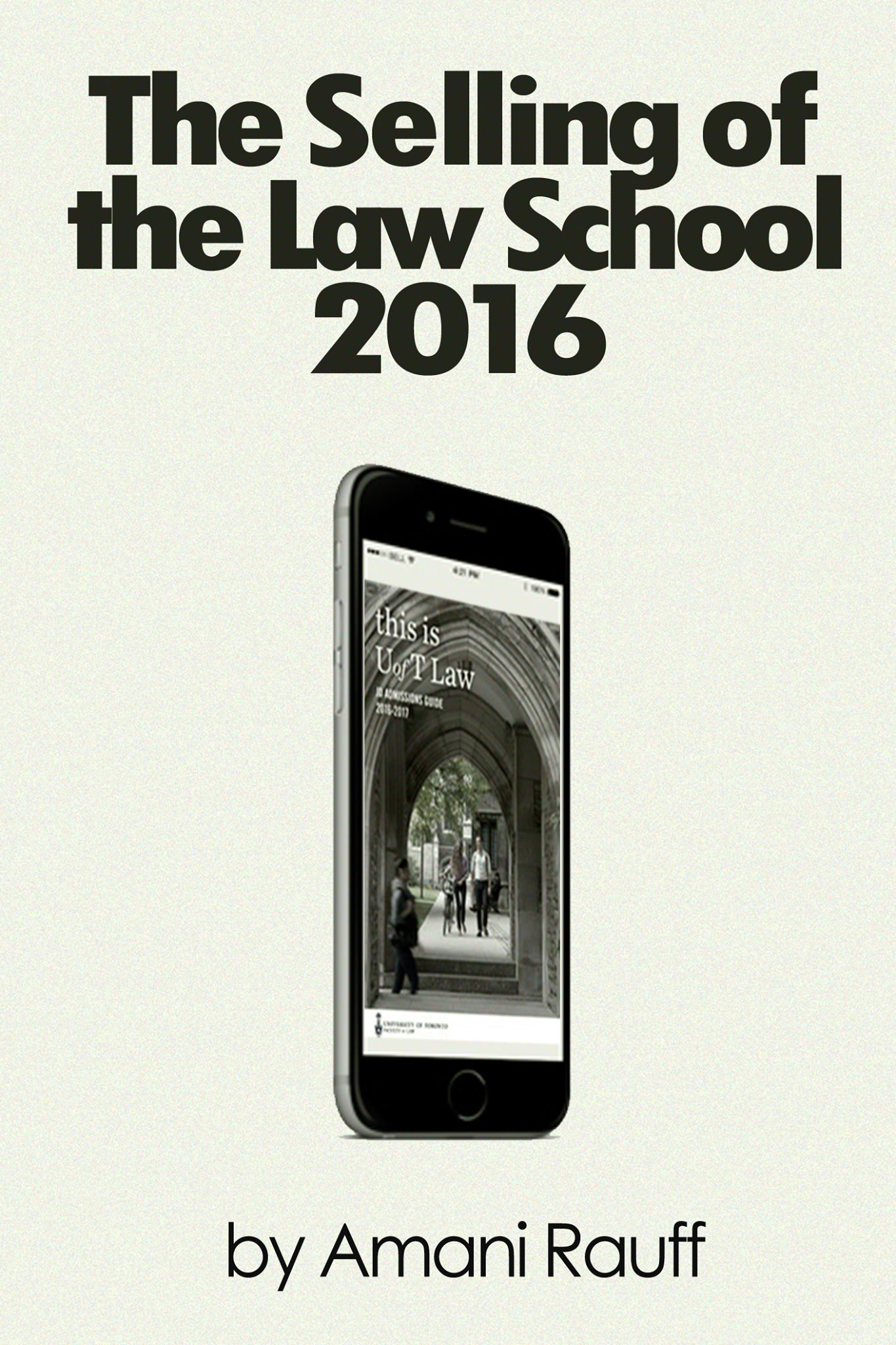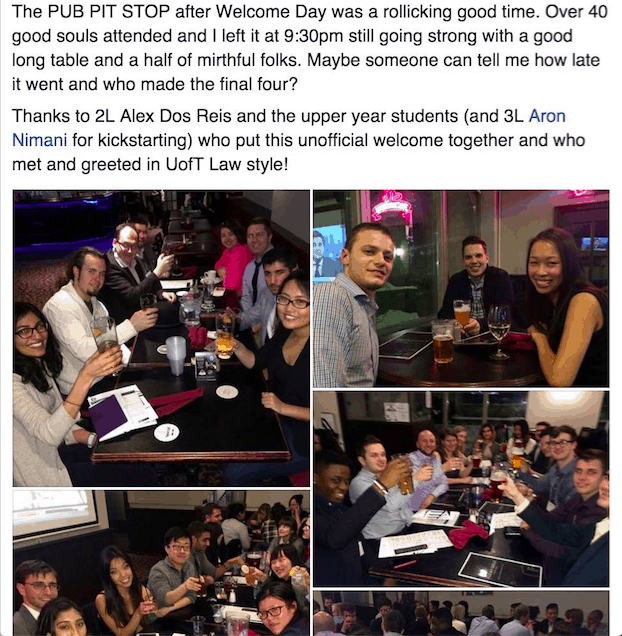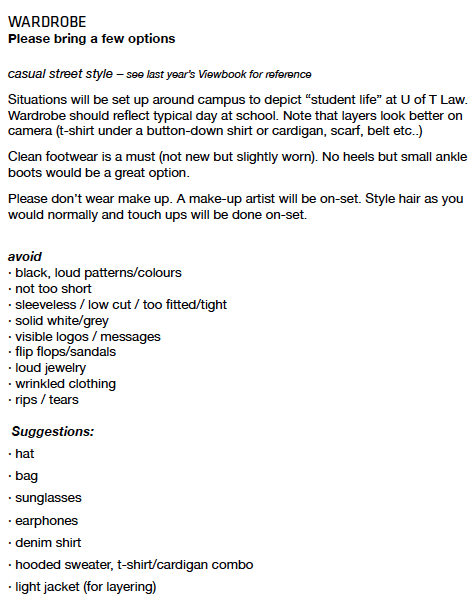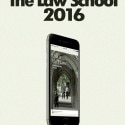Amani Rauff (1L)
Hard work goes into maintaining U of T Law’s reputation for “excellence.” Every year, prospective students decide that it offers something worth $10,000 to $20,000 more than other Canadian law schools. While some of the gap may be offset by financial aid, the difference is often enough to leave many students on the fence about whether to apply, or accept an offer. Communication strategies can help.
“Toronto was playing a whole different game than the other schools when it comes to admissions,” reported second-year student Zachary Al-Khatib. The financial aid assessment “changed things a little,” but did not quite justify leaving his home province of Alberta. The school’s outreach ultimately made the difference.
Al-Khatib was impressed by the promptness and personalized attention the Faculty put into responding to his concerns. He also appreciated the tailored welcome package—a personal phone call, a couriered acceptance package, letters signed personally by the Dean. “They explicitly communicated that they wanted you.”

The Message
Assistant Dean Alexis Archbold, who oversees admissions, said the Faculty of Law has at least two key messages for prospective students: the strength of the “program” and the “community.” But with a reputation for excellence, says Archbold, comes a reputation for exclusivity. One of the main communication challenges is “that it’s really hard to get in” and so the Faculty seeks to “communicate that we are a great law school for students from all segments of Canadian society, who have interests from across the spectrum […].”
Another challenge is the perception that the law school has a strong “corporate” or “Bay Street” focus. “We worry,” said Archbold, “that our brand that’s out there conveys messages [based on which] certain students would select out.”
The Faculty attempts to address these issues in two ways. First, by “correct[ing] the record, say[ing] that we’re not a Bay Street school…[that] we think of ourselves as a very strong program that students who have a variety of interests may choose to come to.” And second, through outreach methods such as offering application fee waivers, and employing a “holistic” admissions process.

Of course, some might question whether these efforts “correct” the record. Concerns about rising tuition, stagnating financial aid funds, and a focus on Bay Street jobs have been hot button issues within the school, not just for prospective students, for over a decade.
Asked whether the Faculty agreed with admissions director Jerome Poon-Ting’s statement to Ultra Vires last year implying that the law school’s reputation for inclusivity and affordability is largely a messaging problem, Archbold did not answer directly. She emphasized the school’s efforts to promote the financial aid program to prospective students who might be dissuaded by the “sticker amount.”
How the School Reaches Out
U of T Law communicates with prospective students—and the general public—through several outlets. These include its website, social media, welcome events, and promotional materials, like the JD Admissions Guide and Nexus (the alumni magazine).
The Faculty retains an in-house Director of External Relations, Lucianna Ciccocioppo. She is the Executive Editor of Nexus, and responsible for overseeing the website, social media, media relations and media training, video production, and alumni communications. The Faculty also retains a part-time Web Communications Officer, and collaborates occasionally with University of Toronto Communications.
Welcome Events and Receptions
The school has a number of unpaid JD Ambassadors. According to the online application, these are students who volunteer to “engage with prospective students, applicants and newly admitted students to motivate them to enrol in the Faculty.” Qualifications to apply include good academic standing, enrolment in the JD program, and the willingness and ability to be a “positive and responsible representative of the Faculty and University.”
Asked about what it meant specifically to be “positive,” Assistant Dean Archbold responded that “we’re looking for folks who have very strong or positive experiences being law students, and that they convey that experience to prospective students.” While the Ambassadors undergo training on how to provide tours and on the sorts of questions they might expect to encounter, Archbold stressed that they are not limited in the insights they may share with prospective students.
Some students who attended Welcome Day and the receptions, however, were left with the impression that there were limitations, Faculty-created or not. One current first-year student felt that Welcome Day did not provide her with much opportunity to “know what the school is actually like,” and that it lacked transparency. On the “Inside Scoop: Student to Student” panel, she commented, “We were asking questions about debt, hiring, and the workload, and the answers were the same as those in the pamphlets and what the Faculty said. It felt very compelled.”
Another first-year student, Aamir Chherawala, who attended last year’s Vancouver reception, had a different experience. He thought “they were really honest to us” and fondly remembers speaking with upper-year students on a variety of issues. On the perceived competitiveness of students, he was told by a student, “We don’t really like the word ‘competitive’—we prefer ‘cooperative’—everyone is trying to do well but no one wants anyone else to fail. It’s like golf; you want to increase your own score but aren’t trying to mess up the other side.” Chherawala continued, “I think that was a really great analogy and describes the student body here very well.”
One graduating student, who attended one of the luncheons, remembers appreciating that the school was going to the effort to meet with students and pay for a “swanky” lunch. However, what stands out now, three years later, is the emphasis the administration members placed on the new building and the de-emphasis on the inconvenience of relocation. With the advantage of hindsight, she continued, “I may have chosen differently and thought more critically about what was I was being ‘fed’ (in both the metaphorical and literal senses) at that lunch.”
Social Media
On the new Class of 2019 page, admissions staff have been attempting to make admitted students feel at home. One post sought to generate “engagement” from students by asking how they reacted to their admissions phone call.
Another post enthused about the good times that were had at the pub event held after Welcome Day. New admits were also asked who had the distinct honour of being one of the final attendees at the admissions event. The school’s social media accounts are managed by the Senior Recruitment, Admissions and Diversity Outreach Officer, Mr. Jerome Poon-Ting, and Professor Ben Alarie.

Curated Images and Reality
The school’s emphasis on depicting diversity in its promotional materials raises questions about the extent to which the brand reflects reality. Invitations to appear in the JD Admissions Guide, for example, were sent only to select students. According to Assistant Dean Archbold, the reason is that the photoshoot occurs over the summer. To send a general invitation would mean putting “a message out into the mailboxes of students who are overseas or in New York or out-of-province, [which is] not really necessary in light of the fact that we have a very rich pool that are right close by to us.” The students are instead chosen, according to Archbold, because they are local. This includes JD Ambassadors and those working at the law school over the summer.

The new student profiles posted on the Faculty website in September raise similar questions. These are overseen by Ms. Ciccocioppo, who says that students are chosen to share their stories based on names suggested at her editorial meetings with various assistant or associate deans and their colleagues.
When asked how students are chosen for the profiles, Archbold said, “We start to develop those relationships, and once we have a sense of the kind of experience they’ve had, and they’re often very praising and very complimentary about those experiences…[But] that’s not the main reason we ask them. It’s that they have interesting stories and they seem willing to tell those stories.”
First-year student Niveda Anandan was one of the five students profiled on the website this year. During the interview for the profile, Anandan recalls being asked repeatedly if she had struggled. She remembers “emphasizing that [her] parents were upper-middle class and that [she] had a very sheltered life. […] It was a little awkward.”
Shari Nathan was also profiled on the website. She likewise felt that the focus of the piece was not within her control. “I feel like I talked a lot more about bioethics than about my mom. I made a joke about the rivalry with Osgoode because my mom went to Osgoode. Suzanne [Bowness, writer and editor at “creative content firm” Codeword Communications] wanted to dive into that, and asked a lot about my mom.” After the interview, Nathan was emailed asking for further details about her family. The profile was ultimately titled “Following her mother’s inspiration.”
This pattern is also apparent in what numbers the Faculty chooses to share in its promotional materials and what it does not. The JD Admissions Guide and First Year Class Profile proudly display the percentage of “students of colour” at the school, and statistics on everything from whether incoming first-year students are the first in their family to attend law school to whether they would prefer to represent Justin Bieber or Jian Ghomeshi. They lack, however, any breakdown of the economic diversity of the class—information that is arguably important to understanding the sort of “community” one is joining.

These communication strategies can be viewed in different ways. They may be commended as an attempt to reach the level of diversity the school aspires toward– students from diverse backgrounds may well be more interested in attending a school whose materials they see themselves reflected in.
Alternatively, absent a genuine commitment to achieving substantive diversity (ethnic, economic, or otherwise), these strategies may be read as a dishonest attempt to hold the school out to be something it’s not.
Archbold said that the Faculty sees communications as “an always-evolving project […] so if students have views about this, or they have ideas about how we could be doing it better, [they’re] always happy to have feedback.”






